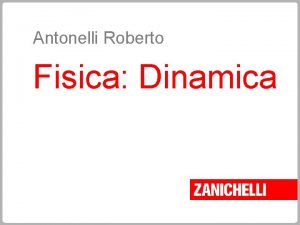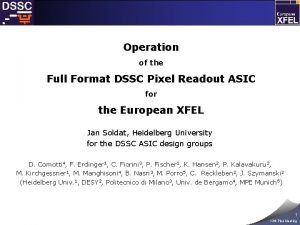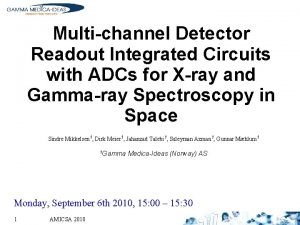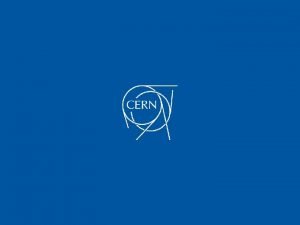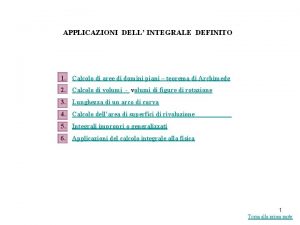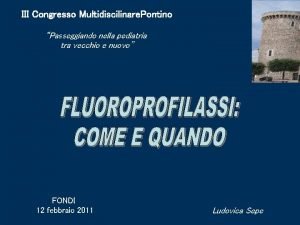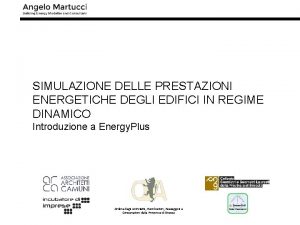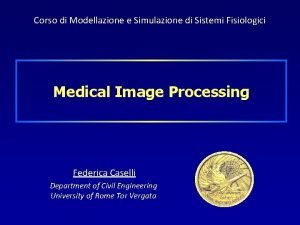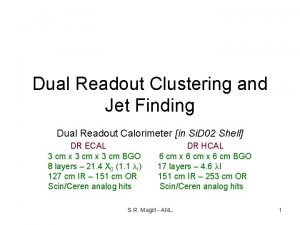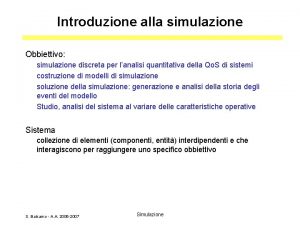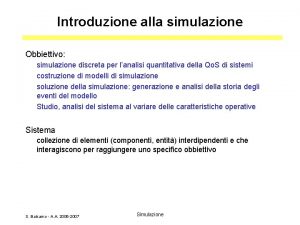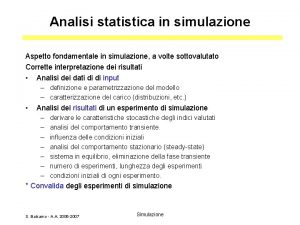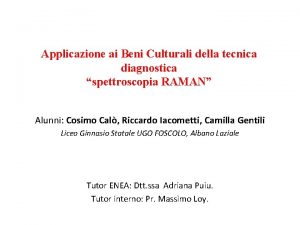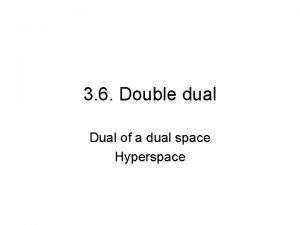Simulazione applicazione della tecnica del dual readout M












- Slides: 12

Simulazione: applicazione della tecnica del dual readout M. Bongi, S. Bottai , 12/11/2015

THE SIMULATION & RECONSTRUCTION TOOL Fluka-based MC simulation ● 3, 6 cm Cs. I Scintillating crystals Scintillation Light collection efficiency and Ø PD quantum efficiency (BGO , PWO ………. . ) Ø Photodiode Energy deposits in the photodiodes due to ionization are taken into account Ø Carbon fiber support structure (filling the gaps between crystals) Ø Number of crystals passed via parameter Ø ● New dedicated versions for Cherenkov and Neutrons detection added recently (to be finalized and eventually ‘unificated’ with standard version) C++ reconstruction tools q Noise q Shower axis reconstructed by fit q Lateral and longitudinal profiles respect to axis q Point of first interaction along axis q Length from first interaction to end of calorimeter q - . . . . . No MC truth is needed in the analysys

DUAL READOUT IN CALOCUBE APPLY THE C/S CORRECTION TO CALOCUBE S/E Scorrected/E Vertical protons E=100 Ge. V, interacting in the first layer RMS=22% RMS=20% C/S C=cherenkov and S=scintillation signals properly normalized C/S RESOLUTION IMPROVEMENT ~ 10% 3

ACCESS CALORIMETER : THIN SAMPLING CALO Vladimir Nagaslaev, Alan Sill, Richard Wigmans TEST BEAM ANALYSIS ~ 10% IMPROVEMENT DUE TO DUAL REDOUT ~ 10% 4

E=Ee +Eh Ee =E*fem Eh =E*(1 -fem) Sem =Ee * ke Energy lost in ionization by electromagnetic fraction Shad =Eh * kh Energy lost in ionization by hadronic fraction calorimeter Shad =Eh * kh Nucl excit. , neutrons, p leak. ! E E E Sem =Ee * ke Typical values in our calo ke ~ 0, 95 E h p+/- kh ~ 0, 1 -0, 2 5

With Scintillation only we see total contribution to energy loss Erec=a Stot=a(Sem+Shad)=a (Ee * ke + Eh * kh )=a (fem * E * ke + (1 -fem)*E * kh ) If ke ≠ kh the fluctuation of fem induce a fluctuation on Erec If ke = kh Erec= a (fem * E * ke + (1 -fem)*E * kh )= a ke E the fluctuation of fem DOES NOT induce a fluctuation on Erec BUT ALSO FLUCTUATIONS ON kh PLAY THE GAME 6

2, 8 l I CSI calo – 10 Te. V s=20 % Electromagnetic fraction (fem) 2, 8 l I CSI calo – 10 Te. V s=38% Kh=Had Energy dep/Had Energy

With Scintillation only we see total contribution to energy loss Erec=a S=a(Sem+Shad)=a (Ee * ke + Eh * kh )=a (fem * E * ke + (1 -fem)*E * kh ) Scintillation + Cherenkov (or neutrons) give information separately on Sem and Shad (not on Eh) THE 'IDEAL' DUAL READOUT ALLOWS TO PERFECTLY MEASURE Sem and Shad propagating errors with approx of gaussian independent distributions Typical values in our calo ke ~ 0, 95 kh ~ 0, 1 -0, 2 Once we know Shad , to reconstruct Eh, E, fem we need to use the constant 1/<kh> which can be large and hence increase the fluctuations of kh term 8

STUDY OF CHERENKOV CORRECTIONS METHODS VERSUS CALO DEPTH NEW SIMULATION x 3 q WE SELECT 8 DIFFERENT SET OF VERTICAL SHOWERS FAR FROM BORDERS. q IN EACH SET THE SHOWERS HAS FIRST INTERACTION IN THE SAME CSI LAYERS q IN EACH SET THE SHOWERS SEE THE SAME CALO LENGTH FROM FIRST INT. TO END q THE 8 SETS CORRESPONDS TO 8 DIFFERENT CALO DEPTH FROM 5, 6 l. I TO 1. 6 l. I 9

4 Erec = a * S methods of energy reconstructions compared SCINTILLATION ALONE Use Cherenkov/S to correct S (S/E) (all showers see the same calo length, no length correction needed) (A. Para) C/S Cherenkov correction ‘DREAM’ like S=E [ fem+(1 -fem) (<kh>/<ke>) ] C=E [ fem+(1 -fem) (<kh>/<ke>)c ] R=[1 - (<kh>/<ke>)c ] / [1 - (<kh>/<ke>) ] Ideal ‘dual’ detector , Se and Sh taken separetely event by event from simulation truth 10

s(Erec-E)/E (%) RESULTS 1, 9 l. I 10 Te. V protons Scintillation alone Cherenkov corr. C/S 3 l. I Chrenkov corr. Dream Ideal ‘dual’ detector standard Calocube 20 x 20 1, 9 l. I 5, 7 l. I CSI Calo length from 10 interaction to end (cm) The resolution gain is roughly equivalent to add ~3 CSI plane 11

Relative Resolution Gain 1, 9 l. I 10 Te. V protons Scintillation alone Cherenkov corr. C/S 3 l. I 5, 7 l. I standard Calocube 20 x 20 1, 9 l. I Relative Resolution Gain s(Erec-E)/E (%) Resolution with Cherenkov corrections (gaussian fit to peaks) 1, 9 l. I 10 Te. V protons Scintillation alone Cherenkov corr. C/S 3 l. I Chrenkov corr. Dream Ideal ‘dual’ detector standard Calocube 20 x 20 1, 9 l. I 5, 7 l. I CSI Calo length from 10 interaction to end (cm) 3 l. I 5, 7 l. I Cherenkov corr. C/S CSI Calo length from 10 interaction to end (cm) Relative Resolution Gain s(Erec-E)/E (%) 0 interaction to end (cm) 10 Te. V protons CSI Calo length from 1 1, 9 l. I 3 l. I 5, 7 l. I Ideal ‘dual’ detector CSI Calo length from 10 interaction to end (cm) 12
 I 3 principi della dinamica
I 3 principi della dinamica Nella cmr la presa in carico è un atto complesso
Nella cmr la presa in carico è un atto complesso What is the principle of spectrophotometry
What is the principle of spectrophotometry Full pixel readout
Full pixel readout Readout integrated circuit
Readout integrated circuit Readout units
Readout units Applicazione biotecnologie
Applicazione biotecnologie Integrali applicati alla fisica
Integrali applicati alla fisica Applicazione distribuita
Applicazione distribuita Duraphat applicazione
Duraphat applicazione Simulazione terza prova liceo linguistico
Simulazione terza prova liceo linguistico Simulazione energetica in regime dinamico
Simulazione energetica in regime dinamico Modellazione e simulazione
Modellazione e simulazione
